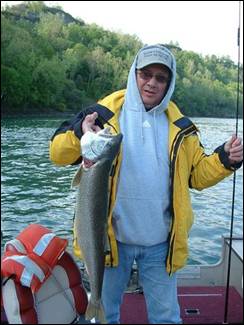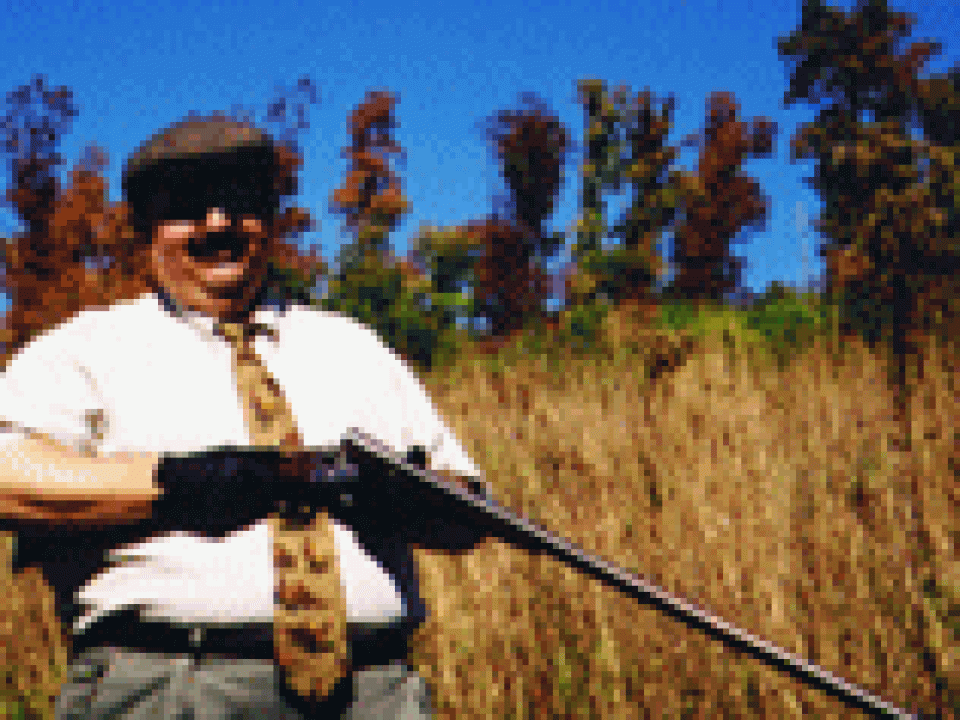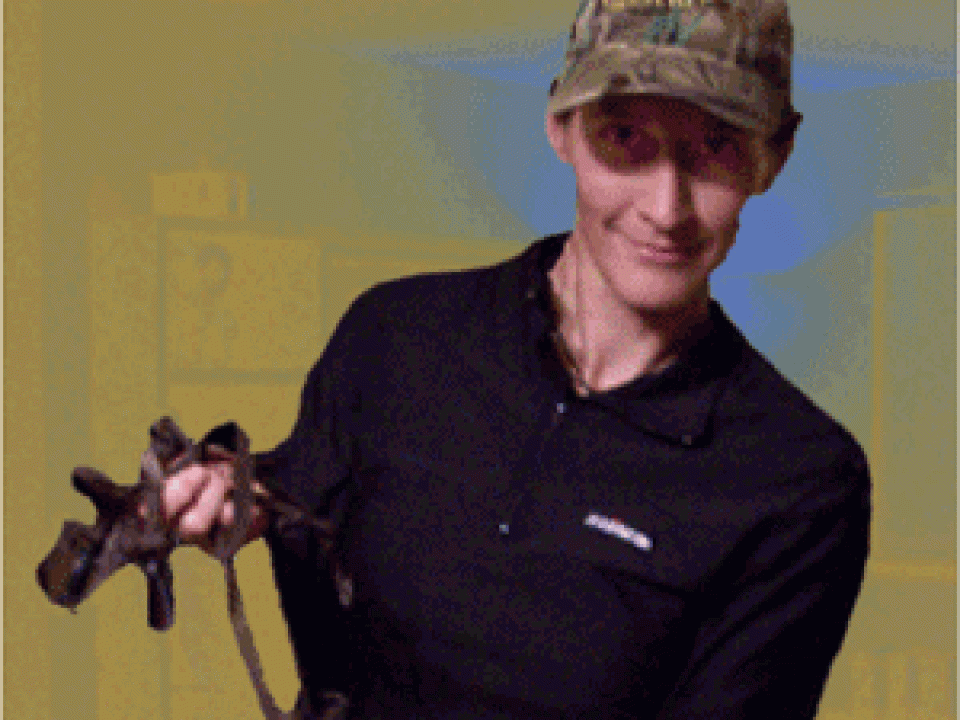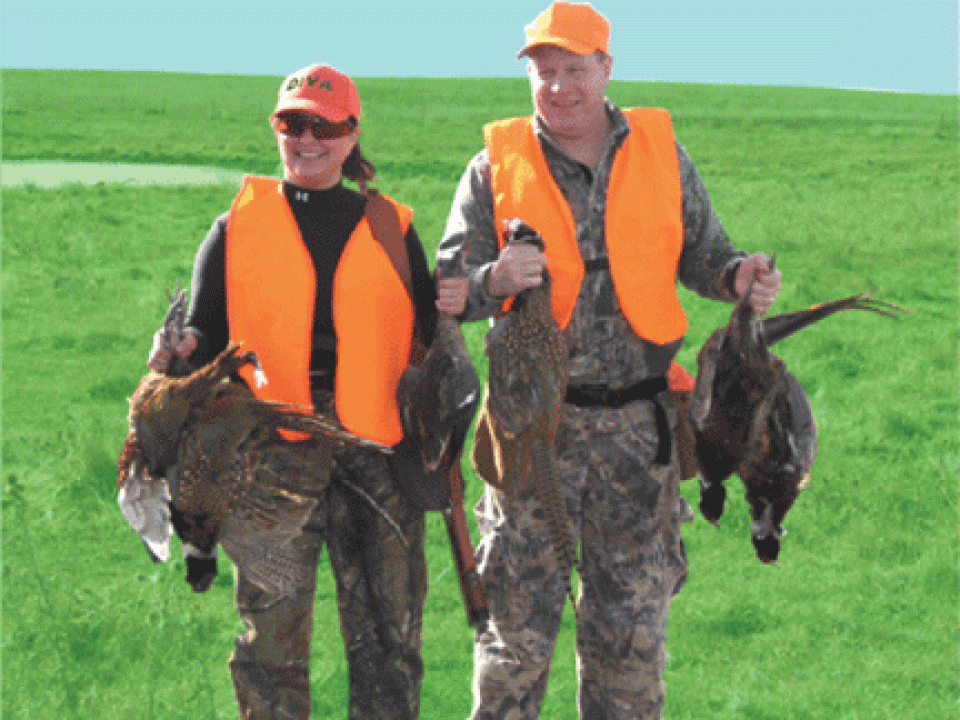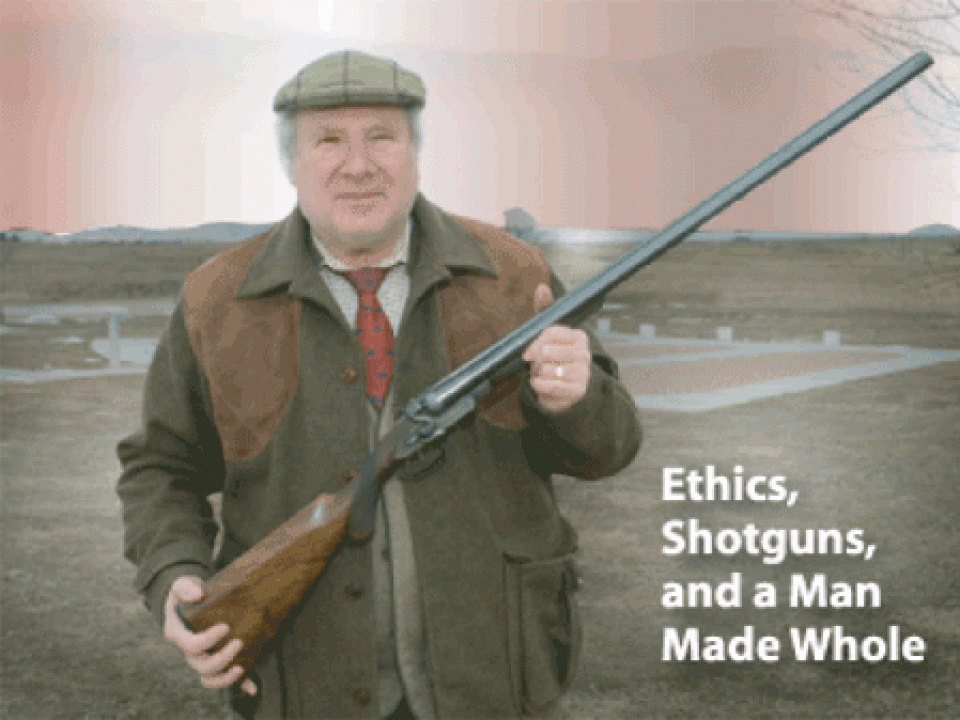GIF


The enigmatic, unfathomable and sphinx-like Georgetown Trout & Gun Club.
The phone rang and I got my assignment: track down the elusive chaps at the Georgetown Trout & Gun Club for a daring exposé in Shotgun Life.
Only in certain circles did the name Georgetown Trout & Gun Club ever bubble to the surface. It was the equivalent of the Order of Skull & Bones at Yale that counted presidents, spies and billionaires among its ranks.
The Georgetown Trout & Gun Club was a name never spoken — only whispered with great reverence.
Members valued their privacy above all else. If you were fortunate enough to ever find yourself in the company of a member, you could never ask about the club. His customary reply is that the organization was established to promote interpretive dance.
The national media was all abuzz when the Georgetown Trout & Gun Club turned down the Washington Post for an interview. And the group’s reticence doesn’t stop there.
Most queries about membership fall into a black hole of silence. Or if you did receive a reply, it’s usually one word.
In our Information Age, you have to really dig deep for the smallest scraps of intelligence about this private men’s society.
An Extraordinary League
They say it was founded 700 years ago and is now the oldest and most exclusive sporting club in the country — if not the world.
It is “the extraordinary league of very ordinary gentlemen,” yet when you dig into the annals of the organization the members seem far from ordinary.
A former FBI spy who is serving time on espionage charges was booted from the club for non-payment of dues since 2001.
The club’s Director of Fishing left for Denver (at least that’s what he said) as part of the Federal Witness Protection Program.
Then there’s the Chairman…
He is only shown in photos as Sir David Niven. The Rules Committee stipulates that members must stand when the Chairman enters the room. The Chairman is always the last to enter and the first to leave. And he is never to be addressed by his Christian name, only as Mr. Chairman.
GIF


The Chairman (David Niven, right) bestows the traditional ballerina trophy to the day’s champion.
The Chairman is known for reciting The Iliad by heart in local taverns. His favorite diversion on road trips is staying in Howard Johnson motels.
A Powder Keg: The Smith Endowment
And the club’s secret handshake? It’s only known by two people: the Chairman and the Director of Ops.
Despite its secrecy, there was one powder keg that the group managed to quietly extinguish.
It was started by the club’s Smith Endowment, after word leaked that some of them claimed to have fathered children with the notorious blonde bombshell, Anna Nicole Smith.
So now that I finished due diligence on the club, my next step was to make contact. How would I do it? Would I ever get through? Would they completely ignore me? Was bribery appropriate?
The Phone Number
As it turns out, I had an ace in the hole. After digging and digging and digging, I found a phone number. I did a quick Avé Maria before I called it. A man answered. It turned out apparently to be the Director of Ops, since he answered the phone “Ops.”
I politely introduced myself. There was a long pause. I continued that I was with Shotgun Life and could I do a story on the club?
“Sure,” he said. He explained that The Great Challenge was coming up in a few weeks and asked if I would be interested in a press pass.
“You bet,” I said.
“Consider it done. And by the way…”
“Yes?”
“There’s one teeny-tiny stipulation.”
“Of course.”
“You cannot identify our members. You refer to them by their numbers. To shield our privacy, you understand.”
I couldn’t believe my good luck. I must’ve caught him in a good mood — or on the tail end of a three martini lunch. Regardless, I shot him off my email address. Over the next several days, I received missives about the upcoming Great Challenge. Finally, as we neared the date, the actual invitation arrived.
Attention able-bodied men — and The Chairman!
Remember that Saturday is our Great Society’s annual Sporting Clay Tournament in Remington, VA. Due to the success of last years event, we have many more guns attending and it will be much fun as we shoot and eat while enjoying the companionship of our fellow lads in the field. Several non-resident members are traveling from California, Pennsylvania and The Democratic Republic of Congo to compete.
Schedule of lively events:
8:00 am
Arrival, coffee and registration
8:30 am
Identity and gender check
8:45 am
Knife fight
9:00 am
Practice shoot through the APC course
12:00 PM
LUNCH
1:30 PM
The 2008 Challenge begins
3:30 PM
Awards Ceremony
3:30 PM
Departure
Optional
Sonnet reading
another knife fight
Be sure to see the Shooting League page on the club’s website for details, directions, convoy and late breaking news of the event.
This event will define, defy or defile you as a man.
PULL!
Knife fights? What was I getting myself into?
I laid awake nights leading up the Great Challenge. Knife fights was all I could think about. I obsessed over the knife fights. During the day, the distractions of daily life kept my fear at bay. But at night, when I turned off the lamp and lay my head on the pillow and the silence welled up around me…knife fights…glimmering steel in the darkness — and blood!
The final email before the Great Challenge revealed that this manly day of action would be staged at the Shady Grove Kennel and Hunting Preserve. Owned by the renowned trainer, Mr. R.N. Selby, Shady Grove was the venue for the prestigious 2007 Master National Retriever Trial hosted by the Rappahannock River Retriever Club.
Smelling the Pedigree
I could already smell the pedigree of the members.
On the appointed morning I donned my Harris Tweed shooting jacket, tattersall shirt, pheasant tie and Barbour hounds-tooth cap. My shotgun of choice was a 20-gauge Caesar Guerini Magnus — a lovely gun ideal for the highly anticipated Great Challenge.
In addition to packing ammo, water and a clean towel in my waterproof shooting bag, I added a roll of sterile gauze, white adhesive tape, antiseptic ointment and a fresh change of boxer shorts.
Finally, I removed my razor-sharp buffalo knife from its crocodile sheath for a quick once-over: mirrored stainless steel, full tang, trailing point blade with a polished buffalo horn handle. It had been a gift from my beloved uncle, my namesake, Cletus Clapp. I slipped the knife into my bag. There, I was set.
I departed from home just north of Baltimore in the wee hours of the morning, and some two hours later I arrived at Shady Grove in rural Remington, Virginia.
GIF


The Trout One jet (pictured here in an extremely rare photo) has shattered numerous global air-speed records under the steely headship of its Captain, Chairman.
The First to Arrive
The gravel parking lot was empty, but upon my arrival a rugged-looking man pulled up in a sporting-clays cart. With his long Southern drawl, he introduced himself as Mr. Selby. Yes, indeed, I was the first to arrive, he confirmed, and then suggested I take a stroll down the pasture to the safari canopy in the distance, which would serve as the nerve center for the Great Challenge.
The canopy stood under a tree ringed by the sporting- clays stations. There was an underbelly of ominous storm clouds, with the heady scents of imminent rain and fresh-cut grass. The club’s coat of arms waved in the breeze from a low branch.
The hospitable and witty Mrs. Selby introduced herself as she applied the final touches on a beautiful spread of pastries, juice, fruit and coffee. Mr. Selby joined her to help attach the table skirt with Velcro.
Cup of coffee in hand, I mentioned that this was my first time shooting with the gents, and Mrs. Selby chuckled — shooting her husband an all-knowing glance.
Prodding Mrs. Selby
I prodded Mrs. Selby with a few delicate questions about the knife fight, but all she said is that I would enjoy the company of the boys. Mr. Selby remained mum as he worked the Velcro around the table. At the first opportunity, he hopped in his cart and sped off.
With the conversation clearly closed, I decided to reconnoiter the property on foot. The club house was a converted drive-up ATM booth with a sagging wood porch. A few pick-up trucks were parked nearby, some with kennels in the beds. Two Porta Potties stood sentry against the looming storm.
A pair of retrievers frolicked with each other as their owners attended to the property.
The sporting-clays stations looked like short-range shots, but experience taught me that these types of presentations could be tricky with deceiving quartering angles, sudden drops and small windows of visibility. My analysis later proved correct, but I couldn’t possibly foretell what our gonzo trapper had in store for us.
As I walked back to the canopy I noticed two men had arrived. They turned out be members 454 and 302. At the same time, a fetching member of staff in snug jeans named S. had taken to tending the food and beverages. Of course, the lads were preoccupied with S. — a slender, raven-haired beauty with penetrating eyes and a really, really tight body.
What About the Knife Fight?
Introductions all around. One of the members was obviously English, and the other, a former college roommate of the Director of Ops, had flown in from California specifically for the Great Challenge. They gave the impression of being decent sorts. At the first discrete opportunity I asked about the knife fight and everyone seemed to laugh at my expense.
After some chit-chat, a convoy entered the parking lot. The two members took leave for the convoy and I quickly followed.
About 10 gentlemen piled out of the vehicles. The Director of Ops immediately identified me as the new face and extended a hail-hearty welcome. A dashing and hospitable fellow, we walked together back to the canopy in an affable manner. I thought it indelicate to broach the subject of the knife fight with him, not wanting to blow the opportunity for this exclusive exposé at the risk of being pegged a chicken.
So as we sauntered along, he introduced me to members we encountered by their three-digit numbers. Of course I was the picture of decorum, but I judged each handshake by its strength and firmness, assessing whether or not I could take that guy in a knife fight.
Finally, the Chairman
We bantered about under the canopy when, out of the corner of his eye the Director of Ops saw something that turned his countenance sober. “I want you to meet the Chairman,” he whispered.
I glanced in the direction of the Chairman. All I could see was his back. It was a distinguished back, probably hairy based on the thickness of his mane. The Chairman was in the middle of a lesson with the resident pro.
As the Director of Ops accompanied me, he listed all the rules and protocols of greeting the Chairman. After each one, I had to say “Yes I understand” or “No, I do not understand.”
We deferentially waited until the Chairman acknowledged us. Shaking hands I said “A pleasure to meet you Mr. Chairman,” thinking that I could definitely take this guy.
“Welcome, Fielding-Clapp.” And the Chairman returned to his lesson.
“Good form,” the Director of Ops told me as we returned to the canopy.
The Practice Shoot
Soon, the Director of Ops had convened everyone for a pairing of the teams for the Practice Shoot of the Great Challenge. I was in a squad with the Director himself and member 327, a tall chap with an excessively long reach and big hands. Hmmm, I thought.
Ready with gun at hand, I observed the chaps as they prepared themselves. It was 09:00 and since the scheduled identity and gender check had not taken place yet I wondered if the men did it in the cars on the way up here to save time. As for me, well, they either didn’t care about my identity and gender or they had much bigger plans to spring on me.
And what about the knife fight? It too was behind schedule. Everyone seemed blissfully blasé about it as the team-up coalesced. One thing was absolutely certain: I had no intention of bringing it up.
We convened at station 3 for the kick-off of the Practice Session of the Great Challenge. The Chairman prepared to take the first shots. As skill and fortune would have it, the Chairman ran the station, followed by a genteel applause. The 50-round Practice Session of the Great Challenge commenced.
Our Wily Trapper
Our trapper proved to be a husky fellow with a booming laugh named B. We discovered that he worked full time for a military contractor in Virginia. His expertise was submarine logistics. He enjoyed trapping to spend quality time outdoors. He obviously took his profession quite seriously because B.’s trapping skills were every bit as wily and stealthy as a submarine.
He would give us the lookers then change their order when we called for them. He threw targets upside down, the centers punched out, midis, minis, battues — concocting any combination of simos on a whim that would take a contortionist to hit. He especially liked to tilt forward the portable platforms that held the manual throwing machines so the targets angled straight into the dirt. Nothing was too devious for that big lug of a chap and each round would be punctuated with his great booming laugh.
Now that we had the defilement out of the way, I look forward to a hearty lunch.
She Squeezes Between the Lads
We took to our vehicles and drove the few miles to the lodge. The house had a sprawling country kitchen and wide verandah where we ate our build-your-own sandwiches, wraps and savory side dishes. S. would squeeze between the lads ready to fill a glass or take an empty plate. It was a picture-book spring afternoon in this part of Virginia, and everyone was of lively disposition.
I was just about to ask about the knife fight when the Chairman stood and announced that it was back to Shady Grove for the Great Challenge.
With backslapping and fanfare we repaired to our vehicles. I wondered, which I would encounter next: define or defy? Or perhaps I would be defile all over again. Either way, with a full stomach and a perky attitude I was ready for whatever lay ahead in the Great Challenge.
The three-man teams were different this time around. My squad consisted of members 351 and 409, and we were accompanied by trapper, J. — a short wan fellow who was an excellent instructor.
The Chairman Chokes
Once again, the Chairman led with the opening shots followed by a polite applause after choking big time and missing all the targets.
The character of this squad and the Great Challenge itself was markedly more serious. Fifty rounds, and may the best man win.
The pressure of the competition compressed time. Before we knew it, the Great Challenge was over. I fared second in my squad — behind the architect and ahead of the movie producer.
No doubt, we were more than ready for the alcoholic beverages, cheese and crackers and more desserts. It was back to the lodge.
The Dreaded Ballerina Cup
Unbeknownst to me there was a palpable trepidation among some of the members. What I was about to discover is that the man with the lowest score of the Great Challenge wins the dreaded Ballerina Cup.
On the verandah we quenched our thirst with beer, wine and just about anything within reach that contained alcohol. The Director of Operations called the meeting to order with a slam of the gavel. Past, present and future business was covered in true parliamentary procedure, yet the well-lubed lads broke out into rollicking laughter as we moved to the prizes.
The Great Challenge of 2008 would prove to be the biggest upset in the 700-year history of the club. The Chairman took the floor and announced the results. The ace shooters didn’t place at all. The winner’s cup went to member 428. The second-place ribbon was awarded to member 305. And much to my own surprise, yours truly placed third.
Member 413 accepted the Ballerina Cup with fortitude and magnanimity.
Another Heaping of Defilement
The Chairman returned the floor to the Director of Ops. It was time to announce new members. He read off six names followed by their numbers, each garnering a round of applause.
The Director of Ops then called for silence. I felt certain that the knife fight would begin, with yet another heaping of defilement coming my way. This was going to hurt bad.
“We have one more new member to announce,” the Director said. “This is a big surprise, but the decision is unanimous. Let us welcome to the Georgetown Trout & Gun Club, Cletus Fielding-Clapp.”
It certainly generated the biggest applause of the day and I beamed with pride. A few words were called for. The Chairman stood beside me and I thanked everyone for acknowledging me as a member. It was a heady moment, indeed, to be standing right within spitting distance of the Chairman.
The group began to disperse. What an incredible feat, I thought, to become a member of the Georgetown Trout & Gun Club.
As we filed into the parking lot, I managed to find a moment to buttonhole the Director of Ops.
“What about the knife fight?” I whispered.
He looked at me in amazement, then broke out laughing.
Cletus Fielding-Clapp is a Nobel Laureate in the art and science of journalistic writing who is widely credited with coining the maxim of 21st century media: “I never let the truth stand between me and a good story.” You can reach him at letters@shotgunlife.com.
It’s at great peril that we publish the link to the web site of the Georgetown Trout & Gun Club: http://www.georgetownleague.info/. Please be advised that the photos of gentlemen depicted on the group’s web site are professional models paid to shield the real members from the prying eyes of the public.
